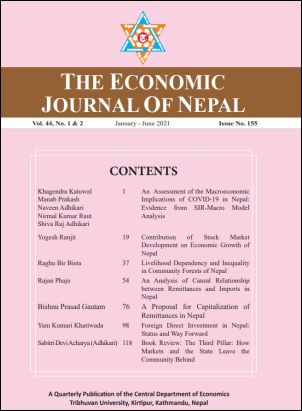Livelihood Dependency and Inequality in Community Forests of Nepal
DOI:
https://doi.org/10.3126/ejon.v44i1-2.55026Keywords:
Public Goods, Poverty, Property Rights, Collectives, Forestry, Forest ProductsAbstract
This study is to examine empirically livelihood dependency and inequality of the community from the community forest in Nepal. This study used the follow up survey data in 2018 in the Kafle Community Forest of Lamatar-6, Lalitpur District, Nepal. The data was collected from household survey to 48 sample household. Gini coefficient was used as analytical tool. As the results, 67 percent households are absolute poor and 23 percent households are relatively poor. The poor households excessively and directly dependent on the forest products of the community forests for their daily livelihood objectives. This study found that community forests contributed 45 percent livelihood income (firewood, leaf litter, and grass, water etc.) to the forest-dependent households, along with service and agriculture income sources. Labor contribution based proportional distribution was used to meet social and economic justice. The poor could get more benefit than the well-off households. Additionally, the study found declining inequality among households after being a member of KCF. Without the income of the community forests, the inequality was 0.99. With the income of the community forests, the inequality sharply dropped at 0.64. Thus, the community forests reduce income inequality and poverty level of the poor households with increasing livelihood security and support. Therefore, the community forests are an effective and collective action to sustainable forest management and livelihood security.
Downloads
Downloads
Published
How to Cite
Issue
Section
License
© Cedecon-TU




